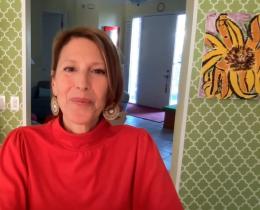Do you compare yourself to other artists? That is just one common strategy of the inner critic to foil our joy. If you never felt like you were good enough growing up, you might have a kind of “disappointment software" which can create resistance or self-sabotage.
Here, Jill offers 9 ways you can empower yourself to notice the inner critic, stand up to it, and find yourself in the state of flow.
- Lower your expectations. We usually have high-pressure expectations of ourselves, so we don’t even want to start creating art. Jill gives artists permission to not do things well—perhaps even terribly—at first. Sometimes this means scribbling to music (Dave Brubeck’s "Take Five" is a favorite), or drawing flowers with your eyes closed. Drawing with your non-dominant hand also helps. For writers, you can write complete nonsense or a bad poem. Getting out of your head—or out of your thinking mind—is what it’s all about.
- Pay attention. Pay attention to all of the little things that bring you joy. The more we feel good about ourselves, the more we are filled with well-being, the more we want to self-express. If you look around your home, there’s probably something on the wall you haven’t seen for a long time. Like a painting or a picture, something that you bought that you no longer see. Jill leads exercises with these rediscovered objects, such as give it a title, write about it, or endow the object with some power.
- Ask questions. Our subconscious loves questions. Sometimes it’s just asking the question and not even needing an answer, it just rewires your circuits. You could use, “When can I find some time to do this writing or painting?" Or, you could ask “How can I make this easier?” As creative people, we sometimes like to make things harder, Jill says. When you ask yourself, “What called you to do this in the first place?” it can help to foster the gratitude and joy that art brings into your life.
- Take really small steps. What causes a lot of blocks is all of these writers and artists that say you have to sit down for four hours every morning and write or paint. It’s not always possible for people to do that. Jill suggests that you sit down for five minutes—you can always stay longer once you’re engaged—but that shuts off the amygdala so that our cortex can get creative. The amygdala is our fear center, saying “I’m not sure what to write. I’m not sure it’s not going to be any good.”
The more you break things down into the smallest steps, the better. Instead of, “What is my book going to be about?” ask, “What would be a good first sentence?”
- Use parallel universe time. People do better in classes and with other people. Jill says she works remotely with a writing partner every week. "We stay on the phone together and hold the space for each other. So we can’t walk away or say, 'I think I’m going to go on Facebook.' It’s a more grounded feeling than trying to write on your own.
- Mind map. If you draw a mind map, maybe put a subject in the middle like “sky” and then put a leg off it to “angry” and then ask, how are they connected? It helps you to get into nonsense, which is another way to get out of judgment. Just be silly. When people play in the nonsense realm, they have ideas they would never have if they tried to stay in the realistic realm.
- Modify things that exist. Some people maintain that you need to come up with something from scratch. But there are many TED Talks about the fact that nothing comes from thin air. Take what other people have done and modify it—giving it your own signature.
- Call on your rebellious teenager. As we go up the ladder of consciousness, Jill says, we catch ourselves more quickly when the inner critic rears its ugly head. That’s when to summon up your inner teenager and hit the inner critic with, “So what, I’m going to do it anyway.” Perhaps you hear, “I’m too old.” Respond, “So what? I’m going to do it anyway.” Or, “You don’t have time for this.” Again, “So what? Doing it anyway!” It just brings out that inner brat we all have. It’s still there.
- Sit (or walk or move) with an idea. There are lots of ideas in our body that get stuck when we are just sitting in a chair. A lot of people have their ideas in the bathtub or driving. "Yoga is such a metaphor for the creative process," Jill says. "Breathing in is an inspiration, breathing out is an expiration. A twist is like a twist on an idea. Where are you directing your mind in the pose?"
More than anything, having fun is Jill’s number one rule to get into the groove.
“I couldn’t write my books or do my art unless they were fun. I find a lot of joy in making people laugh and smile. So, that’s one of my main motivations. And it’s total therapy. Especially in the last couple years, creating your own world and getting lost in this timeless, ageless process, making up creatures and distorting reality. There’s nothing like it.”



